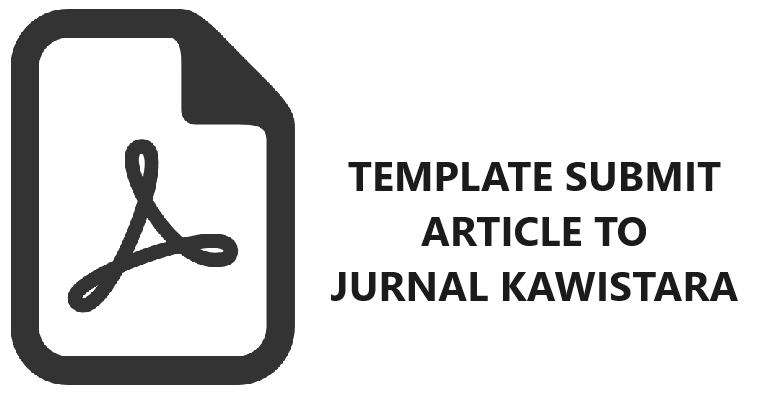Gebrakan dan Penganekaragaman: Budaya Persaingan dalam Pertumbuhan Seni Pertunjukan Rakyat di Boyolali Jawa Tengah
Kiswanto Kiswanto(1*), Tri Joko(2), Aris Dwiyanto(3)
(1) PUI-PT Choreographyc & Artistic Research Institut Seni Indonesia Surakarta
(2) Institut Seni Indonesia Surakarta
(3) Institut Seni Indonesia Surakarta
(*) Corresponding Author
Abstract
This study aims to reveal and explain the cultural practice of competition in the growth of folk performing arts in Boyolali through the monopolistic competition theory approach of Edward Hastings Chamberlin, which has been adapted and developed critically with ethnographic research methods. This research produces findings in the form of a cultural pattern of competition that occurs indirectly among folk performing arts communities in Boyolali. Its characteristics can be recognized by the pattern of development and diversification of works of art between communities which is carried out by adding and producing forms of art that are distinguished from one another. This pattern is built through the process and the result of creativity from the practice of developing, creating, and/or adopting art forms based on the intention to create and present a gebrakan. On the other hand, this process is also part of the diversification process carried out as a strategy to strengthen the community’s positioning in facing market competition. The patterns and strategies developed in it have had a positive impact on the growth of folk performing arts which are increasingly diverse, so that there are many choices of competing art forms that can be chosen to be seen or ordered to be performed.
Keywords
Full Text:
PDFReferences
Anoegrajekti, N. (2011). Gandrung Banyuwangi: Kontestasi dan Representasi Identitas Using. Humaniora, 23(1), 1–15. Retrieved from https://jurnal.ugm.ac.id/jurnalhumaniora/article/view/1007/836.
Bennett, T. (2015). Cultural Studies and the Culture Concept. Cultural Studies, 29(4), 546–568. doi: 10.1080/09502386.2014.1000605.
Chamberlin, E. H. (1969). The Theory of Monopolistic Competition. A Re-orientation of the Theory of Value. (8th Edition,3rd Printing). Cambridge, Mass: Harvard University Press.
Dinas Pendidikan dan Kebudayaan Kabupaten Boyolali. (2017).
Data Kelompok Kesenian Kabupaten Boyolali Tahun 2017. (Unpublished). Boyolali.
Dwihapsari, E. R., & Murni, Y. (2017). Pengaruh Positioning, Diferensiasi dan Citra Merek terhadap Keputusan Pembelian Buku Mimpi Sejuta Dolar dengan Promosi sebagai Variabel Intervening. E-Journal Widya Ekonomika, 1(2), 112–119. Retrieved from https://e-journal. jurwidyakop3.com/index.php/ ekonomika/article/view/269.
Effendi, R. (1996). Marketing Management. Malang: Penerbit IKIP Malang.
Fitriasari, R. P. D., Haryono, T., Simatupang, G. R. L. L., & Abdullah, I. (2012). Ritual Sebagai Media Transmisi Kreativitas Seni di Lereng Gunung Merbabu.Jurnal Kawistara, 2(1), 25–35. Retrieved from https:// jurnal.ugm.ac.id/kawistara/article/ view/3933/3214 99.
Hunt, S. D. (2011). The Theory of Monopolistic Competition, Marketing’s Intellectual History, and the Product Differentiation Versus Market Segmentation Controversy. Journal of Macromarketing, 31(1), 73–84. doi: 10.1177/0276146710382119.
Kayam, U. (1981). Seni, Tradisi, Masyarakat. Jakarta: Penerbit Sinar Harapan.
Kiswanto. (2014). Konsepsi Pemaknaan Kelinthing dalam Pertunjukan Topeng Ireng. (Unpublished Thesis). Institut Seni Indonesia Surakarta.
Kiswanto. (2018). Transformasi Multipel Seni Kuda Kepang Kelompok Turonggo Seto Mardi Utomo Boyolali Jawa Tengah. (Unpublished Thesis). Universitas Gadjah Mada.
Kiswanto, K. (2017). Transformasi Bentuk Representasi dan Performativitas Gender dalam Seni Tradisi Topeng Ireng. Jurnal Kajian Seni, 3(2), 136–149. Retrieved from https://jurnal.ugm. ac.id/jks/article/view/22706/18103.
Kiswanto, K. (2019). Transformasi Multipel dalam Pengembangan Seni Kuda Kepang. Dance and Theatre Review, 2(1), 1–16. doi: 10.24821/dtr. v2i1.3295.
Kotler, P.(2001). Manajemen Pemasaran: Analisis, Perencanaan, Implementasi, dan Kontrol. Jakarta: PT. Prehallindo.
Kotler, P., & Keller, K. L. (2009). Manajemen Pemasaran Jilid 1. Jakarta: Erlangga.
Marcuello, C., & Salas, V. (2001). Nonprofit Organizations, Monopolistic Competition, and Private Donations: Evidence from Spain. Public Finance Review, 29(3), 183–207. doi: 10.1177/109114210102900301.
Mesoudi, A. (2011). Cultural Evolution: How Darwinian Theory Can Explain Human Culture and Synthesize the Social Sciences. Chicago and London: University of Chicago Press.
Murgiyanto, S. (2017). Kritik Pertunjukan dan Pengalaman Keindahan (D. Pramayoza, Ed.). Yogyakarta: Prodi Pengkajian Seni Pertunjukan dan Seni Rupa Sekolah Pascasarjana Universitas Gadjah Mada dan Komunitas SENREPITA.
Nurngaeni, E., Karkono, D. T., & Supriadi. (2019). Reproduksi Seni Pertunjukan Lengger Banyumas pada Kelompok Seni Kencana Laras dalam Perspektif Bourdieus. Peran Akademisi Di Era Revolusi Industri 4.0 Dan Society 5.0 Dalam Mengembangkan IPTEKS. Temanggung: Lembaga Bahasa Sekolah Tinggi Agama Islam Nahdlatul Ulama Temanggung. Retrieved from https://inisnu.ac.id/ prosiding-evi-nurngaeni-drajattri-karkono-supriadi-universitas sebelas-maret-surakarta/.
Pigeaud, T. (1991). Pertunjukan Rakyat Jawa: Sumbangan bagi Ilmu Antropologi (Terjemahan; M. H. Pringgokusumo, Ed.). Surakarta: Dinas Urusan Istana Mangkunegaran Rekso Pustoko.
Poerwadarminta, W. J. S. (1939). Bausastra Jawa. Groningen: JB Wolters’ Uitgevers Maatschappij.
Radhia, H. A. (2016). Dinamika Seni Pertunjukan Jaran Kepang di Kota Malang. Jurnal Kajian Seni, 2(2). Retrieved from https://jurnal.ugm. ac.id/jks/article/view/12140/15099.
Rice, T. (2014). Ethnomusicology: a very short introduction. New York: Oxford University Press.
Santoso. (2014). Tari Turonggo Seto; Sebuah Kreasi Baru Berbasis Rakyat. (Unpublished Thesis). Institut Seni Indonesia Surakarta.
Simatupang, L. (2013). Pagelaran: Sebuah Mozaik Penelitian Seni-Budaya (D. Pramayoza, Ed.). Yogyakarta: Jalasutra.
Soedarsono, R. M. (2010). Seni Pertunjukan Indonesia di Era Globalisasi. Yogyakarta: Gadjah Mada University Press.
Soemaryatmi, & Suharji. (2015). Sosiologi Seni Pertunjukan Pedesaan (A. Rosmiati, Ed.). Surakarta: ISI Press.
Tylor, E. B. (1871). Primitive culture: Researches into the development of mythology, philosophy, religion, art and custom. London: J. Murray.
Williams, R. (1965). The Long Revolution (Pelican Books) (Revised). Ringwood: Penguin Books Ltd.
DAFTAR NARASUMBER
1. Suharmin (52 Tahun), Ketua Komunitas Turonggo Seto Mardi Utomo Dusun Salam, Desa Samiran, Kecamatan Selo Kabupaten Boyolali. 2. Manteb Listanto (28 Tahun), Kreator dan Pelaku Seni Komunitas Kridho Mudo Dusun Tarusari, Kelurahan Tarubatang, Kecamatan Selo, Kabupaten Boyolali 3. Agus Purwanto (35 Tahun), Kreator dan Pelaku Seni Komunitas Saleho Karya Budaya Dusun Bendolegi, Kelurahan Cluntang, Kecamatan Musuk, Kabupaten Boyolali.
Article Metrics
Refbacks
- There are currently no refbacks.
Copyright (c) 2021 Kiswanto Kiswanto, Tri Joko, Aris Dwiyanto

This work is licensed under a Creative Commons Attribution-ShareAlike 4.0 International License.
Jurnal Kawistara is published by the Graduate School, Universitas Gadjah Mada.











